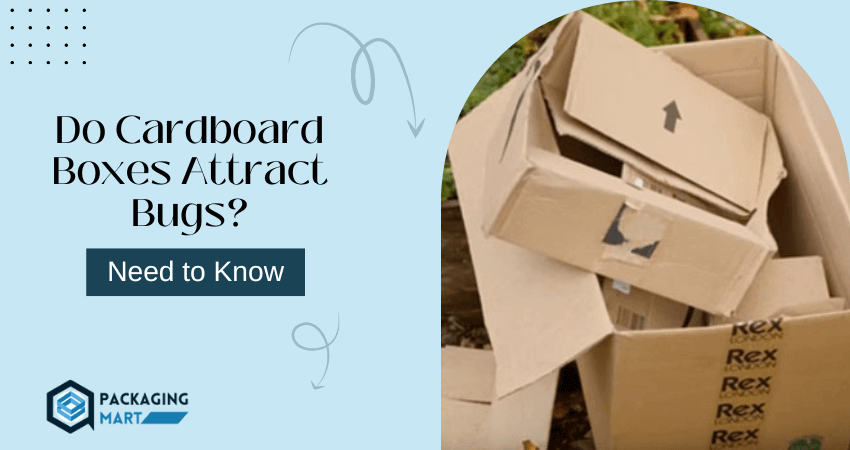Cardboard boxes are one of the most affordable, convenient and eco-friendly materials. They might seem like harmless and useful items because they can make transportation easier and organize your belongings. However, when it comes to pest control, many people ask this question: do cardboard boxes attract bugs? The answer is not quite as straightforward.
In this blog post, we’re going to explore whether or not cardboard boxes can attract pests like cockroaches and more importantly what you can do to prevent any infestations from occurring in your home. Read on for more helpful tips!
Do Cardboard Boxes Attract Bugs?
Cardboard boxes are made up of wood pulp, which is a good food source for some types of bugs. Therefore, it’s not uncommon to find insects attracted to cardboard boxes. Bugs can enter cardboard boxes and nesting materials, but it isn’t likely unless the box has been contaminated with food or moisture.
Cardboard boxes are made of heavy paper pulp and should provide a dry environment that most insects find unsuitable for living.
However, cockroaches can live in virtually any type of environment including cardboard boxes. To protect your items from pests, it’s important to store them in a dry and well-sealed place. If you find any bugs inside the box, immediately discard it and replace it with a new one.
What kind of bugs are attracted to cardboard boxes and why?
Cardboard boxes are attractive to a variety of different bugs. Common ones include cockroaches, silverfish and spiders. These pests are drawn to cardboard because it provides them with the moisture and shelter they need to survive.
Cardboard also offers a great source of food for these insects as it can contain small bits of food residue or even harbor other insects. They offer protection from the elements, including wind and rain and are an ideal breeding ground as they contain essential nutrients such as glue, dirt and paper fibers.
Cardboard also provides a great hiding spot for these creatures to escape predators or other potential threats. If cardboard boxes are left in damp, dark areas they can quickly become a breeding ground for pests such as cockroaches and silverfish. Therefore, it is important to keep cardboard boxes clean and dry to help prevent an infestation.
Additionally, it is important to seal up any cracks or gaps in the boxes to prevent bugs from entering. By understanding why bugs are attracted to cardboard and following these simple prevention measures, you can help keep your home safe and free from pests.
Do cardboard boxes attract cockroaches?
Unfortunately, cardboard boxes can be an attractive home for cockroaches. The porous nature of the material makes it easy for them to hide and nest inside, while its light weight allows them to quickly move around with the box if they need to. Additionally, because cardboard often contains food products or is used to store food items, cockroaches may be attracted to the scent of food coming from the box.
Related Topic: Food Packaging Boxes UK
To prevent these pests from infesting your cardboard boxes, be sure to keep them clean and sealed tightly whenever possible. If you find a cockroach in one of your boxes, discard it immediately and call a pest control company to help eliminate any further infestations. Taking proactive steps will help keep your belongings safe and cockroach-free.
How To Protect Your Boxes in Storage from Attracting Pests/Bugs?
There are a few steps you can take to protect your cardboard boxes from bugs:
- Store the boxes in an area that is not humid and has good airflow, such as inside a garage or shed. This will discourage any bugs from nesting in the boxes.
- Make sure to store the boxes off the ground, such as on a shelf or in plastic bins. This will prevent any bugs from crawling up and into the boxes.
- Regularly inspect the boxes for any signs of infestations and take action immediately if you find any evidence of bugs.
- If possible, store the boxes in sealed plastic bags to keep out pests.
- You can also try putting bay leaves or cloves inside the box to keep insects away.
- If you are storing food items in boxes, make sure to keep them sealed tightly and away from any potential pest sources.
- Regularly clean around the boxes with a vacuum or broom to remove any debris that may attract bugs.
- Use insect repellent inside and around the boxes to help ward off any bugs.
Following these tips will help ensure that your cardboard boxes remain bug-free!
What should you do if you already have a bug infestation in your cardboard boxes?
- Identify the type of bugs present in your cardboard boxes. Different types of bugs require different methods for removal and control.
- Remove all infested materials from the cardboard boxes as soon as possible, including any items that may have been in contact with the bugs. Place these items in sealed plastic bags or containers to prevent the further spreading of the infestation.
- Vacuum the inside and outside of the cardboard box to remove any remaining bugs or eggs. Make sure you dispose of the vacuum bag afterward so that you don’t spread the infestation further.
- Dispose of all infested materials in sealed plastic bags, taking care not to spread the bugs further.
- Clean and inspect the cardboard boxes thoroughly with a damp cloth or damp vacuum cleaner attachment, focusing on any cracks or crevices where the bugs may be hiding.
- Spray an insecticide specifically designed for the type of bug that has infested your cardboard boxes in and around the box’s seams, folds and other areas where the bugs may be hiding.
- Allow the insecticide to dry completely before reusing or storing your cardboard boxes.
- Monitor the box regularly and repeat steps as needed if more bugs appear in the future.
FAQs – Cardboard Boxes Attract Bugs
Does cardboard attract mites?
No, cardboard does not attract mites. While mites may exist in areas where cardboard is present, they typically do not live on the surface of cardboard and would need other organic matter such as food scraps or animal dander to survive.
Additionally, since cardboard is often treated with chemicals designed to resist pests, it can actually be a deterrent for mites. To further protect against mite infestation, it is important to regularly clean and inspect cardboard for signs of damage.
Do cardboard boxes attract spiders?
Cardboard boxes can attract spiders, especially if they are damp. Spiders like to inhabit dark, quiet places where they can spin their webs and catch food without too much disturbance. Cardboard boxes provide just such a place, as well as shelter from the elements.
Additionally, cardboard is made of paper which is composed of cellulose; a material that spiders often use to make their webs. This means that cardboard boxes can be a great source of food for spiders, as they become filled with insects that have been drawn to the box by its dampness.
Do bugs lay eggs in cardboard?
No, most bugs do not lay eggs in cardboard. While some species of cockroaches may be found nesting or laying eggs in cardboard boxes, most other types of bugs will not. Cardboard is not an ideal material for egg-laying because it can contain moisture, which can cause the eggs to rot or become moldy before they have time to hatch.
In addition, cardboard can be difficult for bugs to penetrate in order to lay eggs, making it a less-than-ideal environment for reproduction.
Final Words
Cardboard boxes are one of the most popular packaging materials for household and commercial goods, but you may be wondering if they attract bugs. The answer is yes, cardboard does attract bugs. However, there are ways to prevent this from happening.
By using treated cardboard or storing your boxes in a cool, dry place, you can keep bugs away from your belongings.


